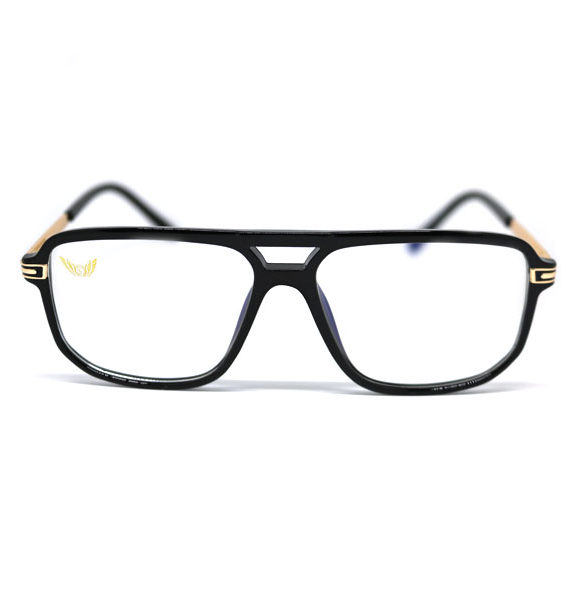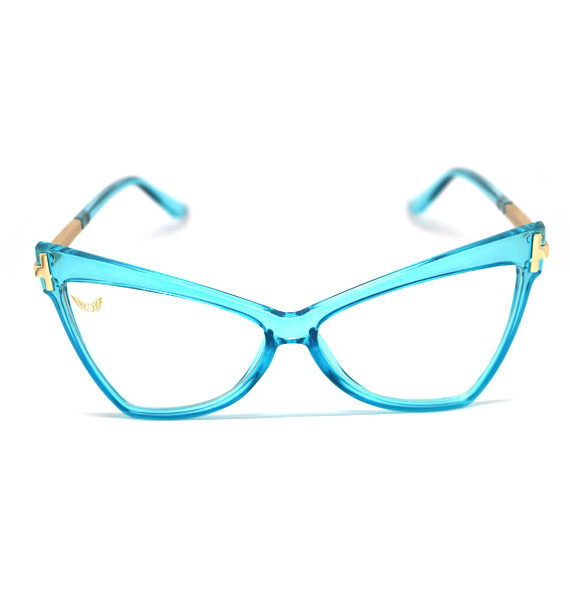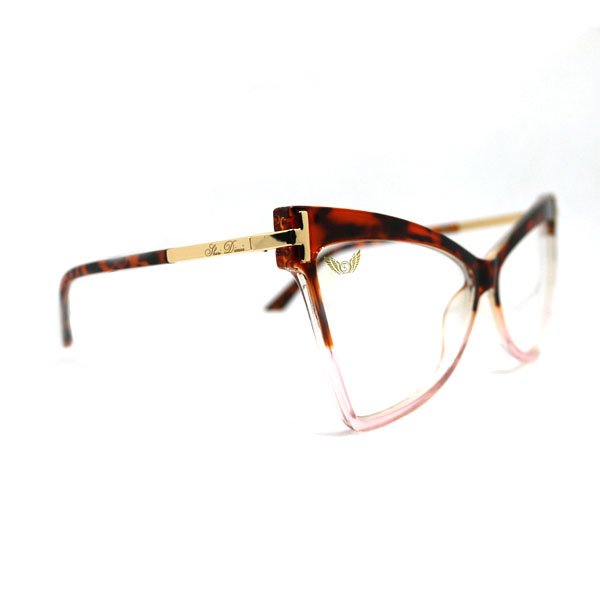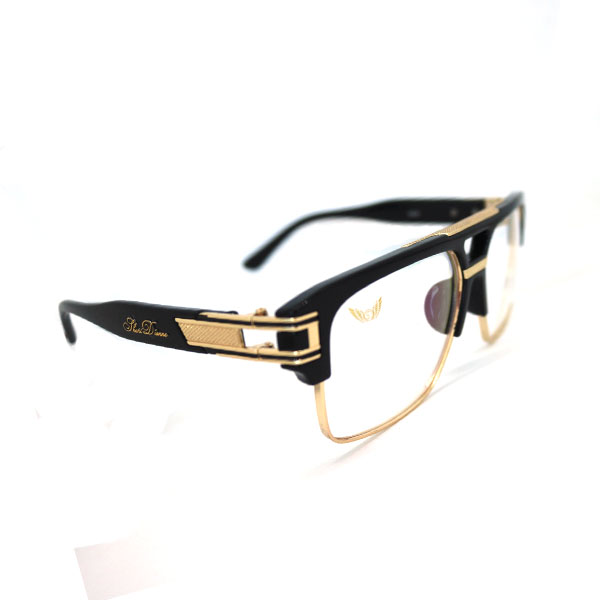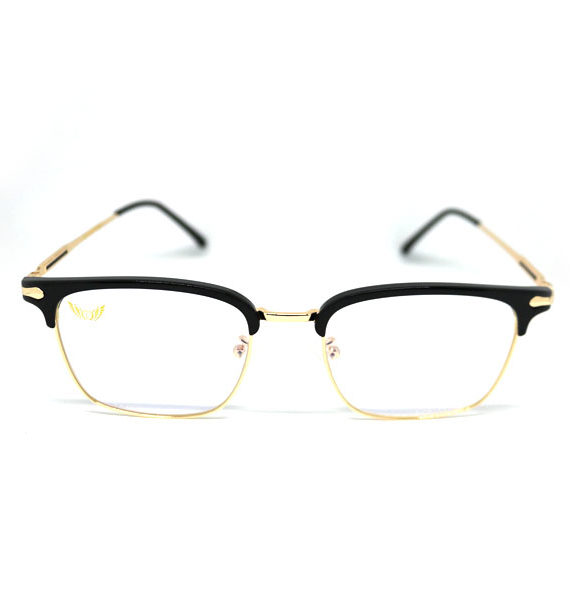Blue light issues originate from the fact that spending more time in front of electronic devices such as laptops, mobile phones, and television set exposes us to far more HEV than we require. Blue light blocking lenses filter out up to 90% of the HEV generated by digital screens, assisting in the relief of eye strain and sleep problems, which are common complaints among computer users. If you work at an office where you have to be glued to a screen or monitor, then you should have blue light glasses that can prevent your eyes from potential damage. Anti-blue light glasses help relieve symptoms of eye strain almost instantly, especially while working at night. Wearing blue light glasses when working on electronic devices may assist in restoring your circadian rhythm and reduce your risk of macular degeneration over time. Protect your eyes in style!
About Blue Light Glasses
What Do Blue Light Glasses Do?
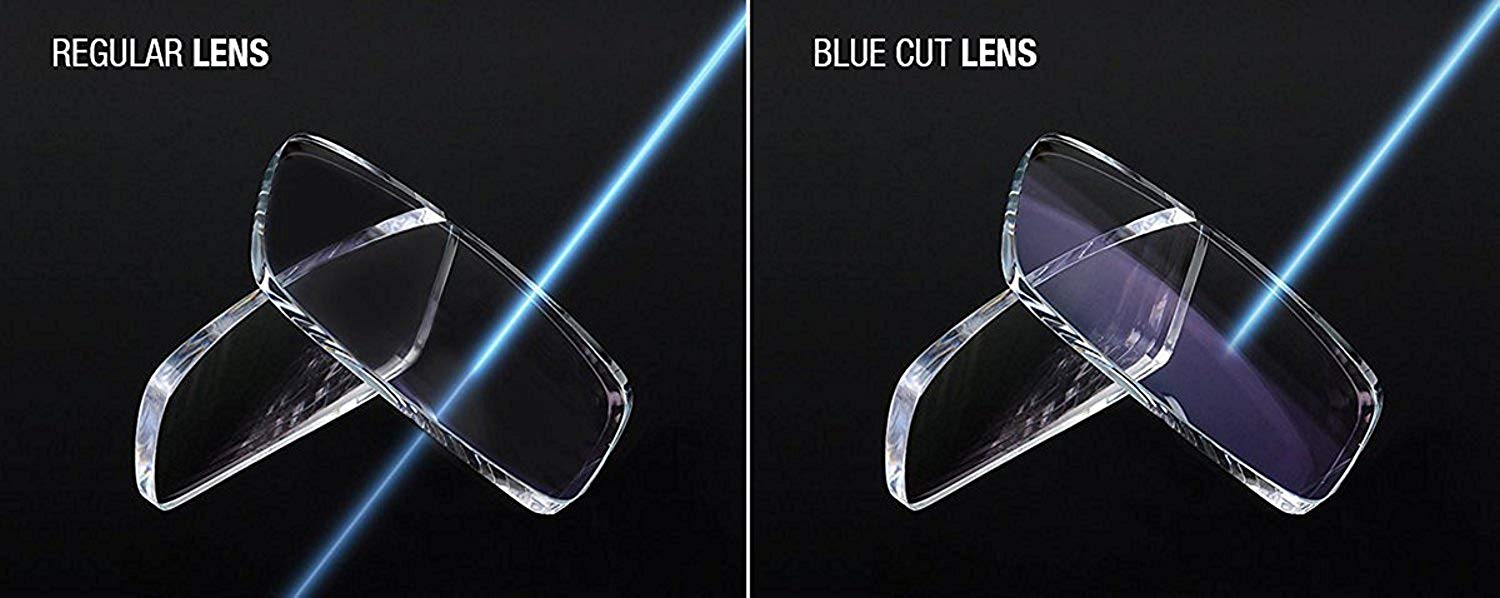
Blue Light Blocking GlassesLook into the future of luxury eyewear by Shari Dionne
Why Get Blue Light Glasses
Computer Screens
As technology becomes increasingly prevalent in our daily lives, it is important to take steps to protect our eyes from the harmful effects of prolonged screen use. One way to do this is by using computer glasses, which are designed to reduce digital eye strain and protect against potentially harmful blue light.
Cellphone Screens
These glasses are designed to be effective at reducing your exposure to blue light between 415-455nm, which can help reduce the negative impacts of long hours spent on your cell phone.
Sleep Better
By wearing blue-blocking glasses, you can help induce dim-light melatonin onset, which can make it easier to fall asleep and get a good night’s rest. If you spend a lot of time in front of screens or live in an environment with high levels of artificial light, blue-blocking glasses can be a useful tool.
What is Blue Light?
Blue light is a term that may sound technical or unfamiliar to some, but understanding its effects is essential for maintaining healthy eyes in today’s digital age. In technical terms, blue light refers to the portion of the light spectrum that includes ultraviolet (UV) rays and is emitted by digital devices and gadgets. These rays are present everywhere, both indoors and outdoors, as we are constantly surrounded by screens and electronic devices.
While some people may dismiss concerns about the potential harm of blue light, it’s important to recognize that prolonged exposure to UV rays can have detrimental effects on our eyes. In a way, blue light can be seen as a slow-acting poison that gradually infiltrates our eyes, leading to a condition known as digital eye strain. Many of us have experienced the discomfort of eye pressure or strain after spending extended periods in front of screens, and this can be attributed to the impact of blue light.
Specifically, blue light falls within the range of 415 to 455 nanometers on the light spectrum. It is characterized by its intense and sharp nature, accompanied by UV rays. When this type of light enters our eyes, it can potentially harm the eye muscles and have negative effects on our vision.
It’s worth noting that blue light is not limited to just digital screens; it is also emitted by other sources such as fluorescent lighting, LED lights, and the sun itself. However, the increased use of electronic devices has significantly raised our exposure to blue light on a daily basis.
Taking steps to protect our eyes from blue light is crucial. This can be achieved through various means, such as using blue light filtering glasses or screen protectors, adjusting screen settings to reduce blue light emission, and taking regular breaks from prolonged screen time. By being aware of the potential harm of blue light and implementing preventive measures, we can help safeguard our eyes and maintain good eye health in the digital era.
The range of blue light on the spectrum is observed as:
How Does Blue Light Affect Us?
Every day, we find ourselves immersed in the digital world, relying on smartphones, tablets, and other electronic devices for communication, information, and entertainment. However, this constant exposure to digital devices also means that we are constantly exposed to blue light. Blue light, technically known as High-Energy Visible (HEV) light, is a type of light with shorter wavelengths and higher frequencies compared to other lights.
The unique properties of blue light allow it to penetrate more quickly and deeply into our eyes. This is due to its shorter wavelength, which enables it to reach the retina more easily. While blue light is present naturally in sunlight and plays a role in regulating our sleep-wake cycles, the abundance of artificial blue light emitted by digital devices has raised concerns about its potential effects on our health.
One significant impact of blue light is its influence on our circadian rhythm, the internal biological clock that regulates our sleep and wake cycles. Exposure to blue light in the evening or at night can suppress the production of melatonin, a hormone that promotes sleep. This can disrupt our sleep patterns and contribute to difficulties falling asleep or experiencing poor sleep quality.
Furthermore, prolonged and intense exposure to blue light has been associated with digital eye strain. Staring at screens for extended periods can lead to symptoms such as eye fatigue, dryness, blurred vision, and headaches. This is because our eyes are constantly focused on the near distance, and the intense blue light emitted by screens can cause strain and fatigue in the eye muscles.
Recent studies have also suggested that excessive exposure to blue light may have long-term effects on eye health. There is growing concern that cumulative exposure to blue light over time may contribute to the development of age-related macular degeneration (AMD), a leading cause of vision loss in older adults. However, further research is needed to establish a definitive link between blue light and AMD.
To mitigate the potential negative effects of blue light, various strategies can be employed. One approach is to limit screen time, take regular breaks, and practice the 20-20-20 rule (looking at something 20 feet away for 20 seconds every 20 minutes). Additionally, blue light-blocking glasses or screen filters can be used to reduce the amount of blue light reaching our eyes, especially during evening hours or before bedtime.
While blue light is an integral part of our daily lives, understanding its effects and taking proactive measures to minimize its impact can help us maintain healthy eyes and sleep patterns in our increasingly digital world.
The color spectrum of light is as follows:
Blue Light Glasses Benefits
Blue light glasses serve as a protective aid, effectively shielding your eyes from direct penetration of harmful blue light. By blocking out the detrimental blue light and allowing only essential light to pass through, these glasses offer several benefits:
- Improved Sleep: Prolonged exposure to blue light, especially in the evening or before bedtime, can disrupt the production of melatonin, a hormone crucial for regulating sleep-wake cycles. Blue light glasses help in reducing the impact of blue light on melatonin levels, promoting better sleep quality and maintaining a healthy sleep pattern.
- Reduced Eye Strain: Staring at screens for extended periods can strain the eye muscles and lead to symptoms like eye fatigue, dryness, and discomfort. Blue light glasses alleviate eye strain by minimizing the amount of blue light entering the eyes, allowing them to relax and reducing the burden on the visual system.
- Alleviation of Headaches: Blue light has been linked to the onset of headaches and migraines in some individuals. By filtering out the specific wavelengths of blue light that can trigger headaches, blue light glasses provide relief and reduce the intensity and frequency of these painful episodes.
- Decreased Risk of Eye Diseases: Blue light, particularly in the high-energy range, can potentially cause damage to the retina over time. By wearing blue light glasses, you can significantly reduce the amount of harmful blue light reaching the retina, thereby lowering the risk of developing eye conditions such as macular degeneration, cataracts, and other age-related vision problems.
It’s important to note that while blue light glasses offer these benefits, they do not eliminate all blue light entirely. The glasses selectively filter out specific wavelengths, primarily those in the high-energy range, while still allowing beneficial light to pass through. This balance ensures that you receive the necessary light for visual perception and overall well-being, while minimizing the potential harm caused by excessive blue light exposure.
By incorporating blue light glasses into your daily routine, you can safeguard your eyes, enhance your visual comfort, promote healthy sleep patterns, and potentially reduce the risk of long-term eye-related conditions.
Do Blue Light Glasses Help with Headaches?
Blue light glasses may help with headaches for some individuals, particularly those who experience headaches or migraines triggered by light sensitivity or prolonged screen time. However, it’s important to note that the effectiveness of blue light glasses in relieving headaches can vary from person to person.
Headaches triggered by light sensitivity, known as photophobia, can be influenced by exposure to certain types of light, including blue light. Blue light glasses work by reducing the amount of blue light that reaches the eyes, which can help alleviate the intensity of light and potentially decrease the likelihood of triggering or worsening headaches.
Additionally, prolonged screen time and digital eye strain can contribute to tension headaches and eye discomfort. Blue light glasses, by reducing eye strain and fatigue caused by blue light exposure, may indirectly help alleviate these types of headaches.
However, it’s important to understand that headaches can have various causes, and not all headaches are related to blue light or digital eye strain. If you frequently experience headaches, it’s recommended to consult with a healthcare professional or an eye care specialist to determine the underlying cause and explore appropriate treatment options.
While blue light glasses may provide relief for some individuals, they are not a universal solution for all types of headaches. It’s also important to ensure that the glasses you choose are of good quality, specifically designed to block or filter out blue light within the desired wavelength range. Consulting with an eye care professional can help in selecting the most suitable blue light glasses for your specific needs.
Blue light glasses may offer relief from headaches associated with light sensitivity or digital eye strain for some individuals. However, the effectiveness can vary, and it’s recommended to seek professional advice for proper diagnosis and treatment of recurrent headaches.
When Should You Wear Blue Light Glasses?
Blue light glasses are the only thing that can protect the eyes from exposure to blue light. Blue light refers to digital light that is propelled through the television screen, laptops, and smartphones. These rays are also produced by the sun and are the UV rays that put stress on the retina and cornea. These glasses should be worn by everyone who has to be exposed to blue light for a long time. If you work at an office where you have to be glued to a screen or monitor, then you should have blue light glasses that can prevent your eyes from further damage. If you want to maintain the circadian rhythms and enjoy a night of peaceful sleep, then it is highly recommended that you wear blue glasses all the time. These glasses do not have to be worn at a specific time, instead, they can be worn any time when you use a gadget or are exposed to sunlight.
Here are some instances when wearing blue light glasses can be particularly helpful:
- During Screen Time: If you spend a significant amount of time using digital devices such as computers, laptops, smartphones, tablets, or gaming consoles, wearing blue light glasses is recommended. These devices emit high levels of blue light, and wearing the glasses can help reduce eye strain, minimize the impact on sleep patterns, and protect your eyes from potential long-term damage.
- Evening and Nighttime Use: Blue light exposure in the evening and at night can disrupt the body’s natural sleep-wake cycle by suppressing the production of melatonin, a hormone that regulates sleep. If you use electronic devices or are exposed to artificial light sources in the evening, wearing blue light glasses can help mitigate the negative effects on sleep and promote better sleep quality.
- Work Environments with High Blue Light Exposure: If your work involves spending long hours in front of computer screens or under intense fluorescent lighting, wearing blue light glasses can provide relief from eye strain and minimize the impact of blue light on your visual health.
- Indoor Environments with Artificial Lighting: Even indoor environments with artificial lighting, such as offices, classrooms, or shopping centers, can expose you to blue light. Wearing blue light glasses in these settings can help reduce eye strain and minimize potential discomfort caused by prolonged exposure to artificial lighting.
- When Experiencing Symptoms of Eye Strain: If you frequently experience symptoms of eye strain, such as dryness, fatigue, redness, or headaches after using digital devices or being in environments with bright artificial lighting, wearing blue light glasses can help alleviate these symptoms and provide relief to your eyes.
Remember, blue light glasses are not necessary for all situations. During daytime outdoor activities or when exposed to natural light, the benefits of blue light glasses may not be as significant. However, if you are sensitive to blue light or have specific concerns about your eye health, wearing blue light glasses consistently can provide ongoing protection and enhance your visual comfort in various settings.
Do Blue Light Glasses Work?
Blue light glasses, also known as blue light-blocking glasses, are designed to filter out or reduce the amount of blue light that reaches our eyes. The effectiveness of blue light glasses in providing benefits depends on several factors.
Blue light glasses can be effective in reducing eye strain and fatigue caused by prolonged exposure to digital devices. By blocking or filtering out a portion of blue light, these glasses help to alleviate the intensity of the light that reaches the eyes. This can result in reduced eye discomfort, dryness, and blurred vision, especially when using electronic devices for extended periods.
Moreover, blue light glasses can aid in regulating sleep patterns. The exposure to blue light in the evening can disrupt our natural sleep-wake cycles by suppressing the production of melatonin, a hormone that promotes sleep. Blue light-blocking glasses can mitigate this effect by reducing the amount of blue light that reaches our eyes, thereby helping to maintain a more natural circadian rhythm and potentially improving sleep quality.
However, it is important to note that the scientific evidence regarding the specific benefits of blue light glasses is still evolving, and the extent of their effectiveness may vary from person to person. While many individuals report positive experiences with blue light glasses, the overall impact on eye health and sleep patterns may depend on factors such as individual sensitivity to blue light, the duration and intensity of exposure, and the quality of the glasses themselves.
When considering blue light glasses, it is advisable to opt for high-quality glasses that have been specifically designed to block or filter out a significant portion of blue light. Look for glasses that offer a blue light protection rating or have a specific wavelength range mentioned, such as blocking blue light in the range of 400-450nm. Consulting with an eye care professional can also provide valuable guidance in selecting the right blue light glasses for your needs.
In summary, while blue light glasses can be beneficial in reducing eye strain and improving sleep patterns for some individuals, their effectiveness may vary. It is best to try them out and assess their impact on your personal comfort and well-being. Additionally, adopting other healthy habits such as limiting screen time, practicing good posture, and taking regular breaks from digital devices can complement the use of blue light glasses in promoting overall eye health and reducing the potential negative effects of blue light exposure.
Blue Light Glasses Test
Testing blue light glasses can help determine their effectiveness in blocking or filtering out blue light. Here are a few methods you can use to test your blue light glasses:
-
Visual Test: One simple way to test your blue light glasses is to observe the visual effects when wearing them. Put on the glasses and look at a digital device screen, such as a smartphone, tablet, or computer. Pay attention to the color of the screen while wearing the glasses. If the glasses are effectively blocking or reducing blue light, you may notice a slight yellow or amber tint to the screen. This indicates that blue light is being filtered out.
-
Blue Light Test Apps: There are smartphone apps available that can help you assess the effectiveness of your blue light glasses. These apps display various colors, including blue light, and analyze how well the glasses filter out or block the blue light. You can download these apps from your device’s app store and follow the instructions to perform the test.
-
Spectrometer Test: A more precise method to evaluate blue light blocking is by using a spectrometer. Spectrometers measure the intensity and wavelengths of light. With a spectrometer, you can measure the amount of blue light emitted by a digital device both with and without wearing your blue light glasses. By comparing the measurements, you can assess the glasses’ ability to block or reduce blue light.
-
Consult an Eye Care Professional: If you want a comprehensive assessment of your blue light glasses’ effectiveness, it is recommended to consult an eye care professional. They have access to specialized equipment that can accurately measure the amount of blue light transmission through the glasses. An eye care professional can provide you with detailed information on the level of blue light protection offered by your glasses.
Remember that these methods can provide a general idea of how well your blue light glasses work, but they may not provide precise measurements. If you have concerns about blue light exposure or the effectiveness of your glasses, it’s best to consult with an eye care professional for a thorough evaluation and personalized advice.
20-20-20 Rule
The 20-20-20 rule, often recommended by eye care professionals, is a simple technique that promotes eye health and reduces eye strain caused by prolonged screen time. The rule is straightforward: after every twenty minutes of staring at a screen, take a twenty-second break to focus your eyes on something that is approximately twenty feet away.
While measuring twenty feet precisely might not be practical for everyone, the key idea is to shift your gaze to a distant object or a point far away from the screen. This could be as simple as looking out of a window at a distant landscape or focusing on an object across the room. The purpose of this practice is to give your eyes a break from the intense near-focus demanded by screens and allow them to relax and readjust.
The twenty-second time frame provides a brief but valuable opportunity for your eyes to rest and recharge. During this short break, you can let your eyes wander and take in the surrounding environment, giving your visual system a momentary respite.
To help implement the 20-20-20 rule effectively, you can set up reminders. For example, you can use an alarm or timer that alerts you every twenty minutes, signaling it’s time to take a twenty-second break. This serves as a helpful cue to remind yourself to shift your focus away from the screen and engage in a brief visual diversion.
By incorporating the 20-20-20 rule into your screen time routine, you can mitigate the strain on your eyes and reduce the risk of developing symptoms like eye fatigue, dryness, and discomfort. This simple technique acts as a form of self-care, allowing you to maintain healthy eyes while appreciating the beauty of the natural world around you for longer periods.



